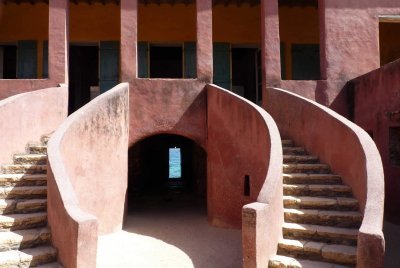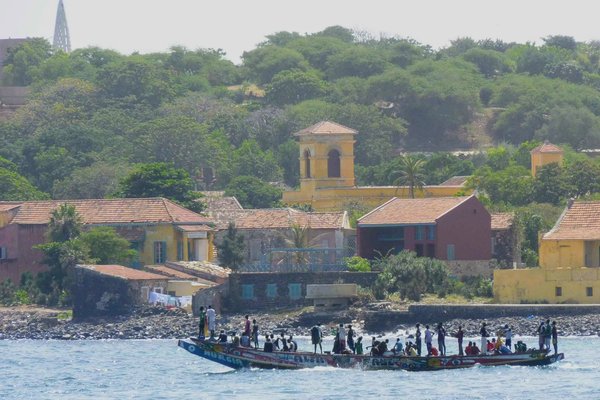Senegal
Island of Gorée
The Island of Gorée is a place of memory for the Atlantic slave trade.
With its strategic location and safe haven, it was one of the first African places to be settled by Europeans. It became a warehouse for slaves brought from the African hinterland to work on the island and be transported to the Americas. It now is a place of memory for the African diaspora.
Community Perspective: It’s not an undisputed place, as the need for a tangible memorial precedes historical accuracy. See Solivagant’s review for more details. The island is a fine and easy half-day trip from Dakar - see Els's review for practical details.
Site Info
Official Information
- Full Name
- Island of Gorée (ID: 26)
- Country
- Senegal
- Status
-
Inscribed 1978
Site history
History of Island of Gorée
- 1978: Inscribed
- Inscribed
- Type
- Cultural
- Criteria
- vi
Links
- UNESCO
- whc.unesco.org
- Official
-
- iledegoree.org — Ile de Goree
All Links
UNESCO.org
- whc.unesco.org — whc.unesco.org/
Official Website
- iledegoree.org — Ile de Goree
Community Information
- Community Category
- Human activity: Transport and Trade
Travel Information
Needs a Ferry
Recent Connections
-
No Map
-
Named after a different location
"The name is a corruption of its origin… -
Needs a Ferry
Ferries can be taken from the terminal …
Connections of Island of Gorée
- Individual People
-
-
Nelson Mandela
Shortly after his release from prison, and before he was elected President of South Africa, Nelson Mandela visited the island and crawled into a cell that had been used for slaves.See apnews.com
-
Sir Robert Holmes
"In sight of the Dutch base at Goree he (Robert Holmes) took the West Indiaman Brill on 27 December 1663. Stirring up the Portuguese, Africans, and even such Dutch merchants as had a grudge against the WIC, he sank 2 ships and captured 2 others under the guns of Goree (22 January 1664, and the next day took possession of the fort itself." (Wiki)
-
- Geography
-
-
Offshore of a major city
Situated in the Atlantic Ocean around 3 kms From Dakar. Ferry journey from main port - near Railway Station. -
Located in a Capital City
Part of the city of Dakar, Capital of Senegal. -
Atlantic Ocean
-
- Trivia
-
-
Built or owned by French
French colony (1677-1960) -
Built or owned by Dutch
1588 - The Dutch chose the island of Gorée to be one of their slave ports. 1659 - The French established themselves on the Island of San Luis, at the mouth of the Senegal River. 1677 - The French seized Gorée. A year later the Treaty of Nijmegen confirmed the conquest. -
Built or owned by British
The island was "ruled in succession by the Portuguese, Dutch, English and French". (Official description) "There were brief periods of British occupation during the various wars fought by France and Britain. The island was notably taken and occupied by the British between 1758 and 1763 following the Capture of Gorée and wider Capture of Senegal during the Seven Years' War".See en.wikipedia.org
-
Built or owned by Portuguese
Built under Portuguese colonial rule, The shipping of slaves from Goree lasted from 1536 when the Portuguese launched the slave trade to the time the French halted it 312 years laterSee www.bbc.com
-
Cultural sites taking up an entire island
-
- History
-
-
Shell Mounds (Middens)
"On Gorée there are four distinct deposits found through excavation and testing. The first kinds of deposition are located on the northwestern and western part of the island, and were typically three metres of domestic debris and shell midden."See en.wikipedia.org
-
WIC
Conquered by the WIC (it was named by the after the Dutch island of Goeree) -
British Military victories over France
Captured in December 1758 by Admiral Augustus Keppel . The island was occupied by the British until 1763 when it was returned under the terms of the Treaty of Paris.
-
- Damaged
-
-
Islands threatened by inundation
There have been numerous WHC "decisions" over the years concerning the unchecked and continuing erosion of Goree including this in 2009 "(The WHC) ... Expresses strong concern about the ongoing erosion of the coastline, particularly in the western part of the island, and its effect on the Relais de l'Espadon and other buildings in the area;" -
Bombarded by the British Navy
the Royal Navy under Admiral Augustus Keppel bombarded the French-occupied fortress on the island and then captured it in December 1758 during the Seven Years War.See en.wikipedia.org
-
- World Heritage Process
-
-
Perfect Inscriptions
1978 -
WHS inscribed solely on Criterion VI
1978 -
First inscriptions
Senegal 1978 -
No Map
-
Inscribed on a single criterion only
vi. to be directly or tangibly associated with events or living traditions, with ideas, or with beliefs, with artistic and literary works of outstanding universal significance. (The Committee considers that this criterion should preferably be used in conjunction with other criteria) -
Reconstruction regarded as unsatisfactory
"The replica of the "Gorée Memorial" on the Castle is an eloquent example of what should be avoided when preserving the integrity of the site and, in agreement with UNESCO, a modification of this work will be undertaken." (Official description)
-
- Religion and Belief
-
-
Notable mosques
Gorée has one of the oldest stone mosques of the country, built in 1890.See fr.wikipedia.org
-
- Human Activity
- Constructions
-
-
Bandstand
-
Prison
The d'Estrées Fortress was used as a civil prison until 1976.See fr.wikipedia.org
-
- WHS on Other Lists
-
-
International Coalition of Sites of Conscience
The "Maison des Esclaves"
-
- Timeline
-
-
Built in the 18th century
Maison des esclaves (1780)
-
- Visiting conditions
-
-
Needs a Ferry
Ferries can be taken from the terminal north of Place de l'Independence. The trip takes 10-20 minutes.
-
- WHS Names
-
-
Named after a different location
"The name is a corruption of its original Dutch name Goeree, named after the Dutch island of Goeree." (wiki)
-
News
No news.
Recent Visitors
Visitors of Island of Gorée
- Adrian Turtschi
- alex
- Alexander Barabanov
- Ali Zingstra
- A. Mehmet Haksever
- Ask Gudmundsen
- Atila Ege
- Bill Maurmann
- Boj
- Christoph
- ctravel
- David Marton
- Don Irwin
- Dorejd
- edstar500
- Els Slots
- Eva Kisgyorgy
- Fernweh
- Fmaiolo@yahoo.com
- Gary Arndt
- George Gdanski
- GerhardM
- Gernot
- Gilles
- Harry Mitsidis
- Iain Jackson
- Janos
- Jarek Pokrzywnicki
- Jay T
- Jeanne OGrady
- jonathanfr
- Jon Opol
- Joyce van Soest
- jxrocky
- Kevin247
- kiank37
- Krijn
- Loic Pedras
- Luis Filipe Gaspar
- Maciej Gil
- Mariam
- Martin
- Michael Novins
- Mikko
- MMM
- Morodhi
- Nihal Ege
- Olli-Pekka Turunen
- palka25
- Paul Schofield
- Philipp Leu
- Pieter Dijkshoorn
- Pink Bunny
- Reza
- Roger Ourset
- Roman Bruehwiler
- Slavi
- Solivagant
- Stanislaw Warwas
- Szabolcs Mosonyi
- Szucs Tamas
- Tevity
- Thomas Buechler
- Thomas van der Walt
- tony0001
- Vanessa Buechler
- Vernon Prieto
- Westwards
- Zsuzsanna Forray
Community Reviews
Show full reviews
It’s just a 20-minute walk from the center of Dakar to the ‘Gare Maritime’ from where the ferries to Gorée leave. This is a well-organized service, with online timetables, clear ticket prices (unchanged for years so it seems, 5200 XOF for the return plus 500 tax), and a boarding area with plenty of seats and a French bakery. It's nothing like the Elephanta ferry I took a month ago from Mumbai – with its lack of signage, old wooden boats and the dirt all around. Just don’t forget to bring your passport here, as it will be checked when you enter the harbour area. If you want to sit at the ferry's top deck, enter via the back entrance and choose a seat on the right for the best Gorée arrival views (I sat on the left, staring at a Maersk containership). The crossing takes just 20 minutes.
The core zone comprises the whole island, which measures about 900x350m. Right off the boat, you walk underneath a Welcome to Gorée-sign that doubles as a Plaque. Check! There’s no shortage of UNESCO WH emblems on display around the island anyway, they are also present on every information panel and at the town hall (hand-painted).
Gorée is a pleasant place to roam around on your own. There are no cars and no persistent sellers or wannabe guides. It has many picturesque small alleys worth checking out. Most buildings date from the late 18th and 19th centuries and were built …
Keep reading 0 comments
I spent several days in Dakar in June 2018. On my first morning, I caught an early ferry to Île de Gorée, which, at least according to UNESCO, was the largest slave-trading center on the African coast from the 15th century to abolition in the 19th century. Although many historians disagree with that assessment, Île de Gorée has become an essential stop for the African diaspora, including President and Mrs. Obama, who visited the Maison des Esclaves and its windowless cells and “door of no return” in 2013. I also visited the slave house, even though academics have generally agreed since the 1990s that the house was more likely to have been a private home than to have been involved in the slave trade. Whether or not Île de Gorée played an important role in the transatlantic slave trade, the small island has become a moving place to contemplate the human toll of African slavery.
Keep reading 0 comments
Goree is a small pleasant island situated a 30minute ferry ride offshore from crowded ugly Dakar. Free of vehicles, its sandy streets are lined with pleasing old houses and flowering shrubs. There is a fort, a castle (with some impressive early 20th century gun emplacements) and several restaurants – in its own right it deserves a visit if you are in Senegal. BUT – beyond these anodyne aspects, lies its claimed “history” as a centre of the Atlantic slave trade and its subsequent emergence as “a memorial to the African diaspora (which) continues to serve as a reminder of human exploitation and as a sanctuary for reconciliation.” (UNESCO long description).
The central point for this “memorial” is the “Maison des esclaves” (photo). Within you will be shown what are said to be slave prison rooms and the “gate of no return” through which slaves were sent to the Americas. You will be regaled with details of the undoubted horrors of the slave trade. You will be shown plaques commemorating the visits of numerous world leaders – a visit is de rigeur for any such person visiting Senegal – Mandela, the Clintons, George W Bush and Pope John Paul II among them.
However, whether this building was ever a slave trading prison and, indeed, whether Goree itself was ever a significant entrepot of the trade is a matter of considerable doubt. But beware - to question any of this is regarded by some as the equivalent of …
Keep reading 0 comments
